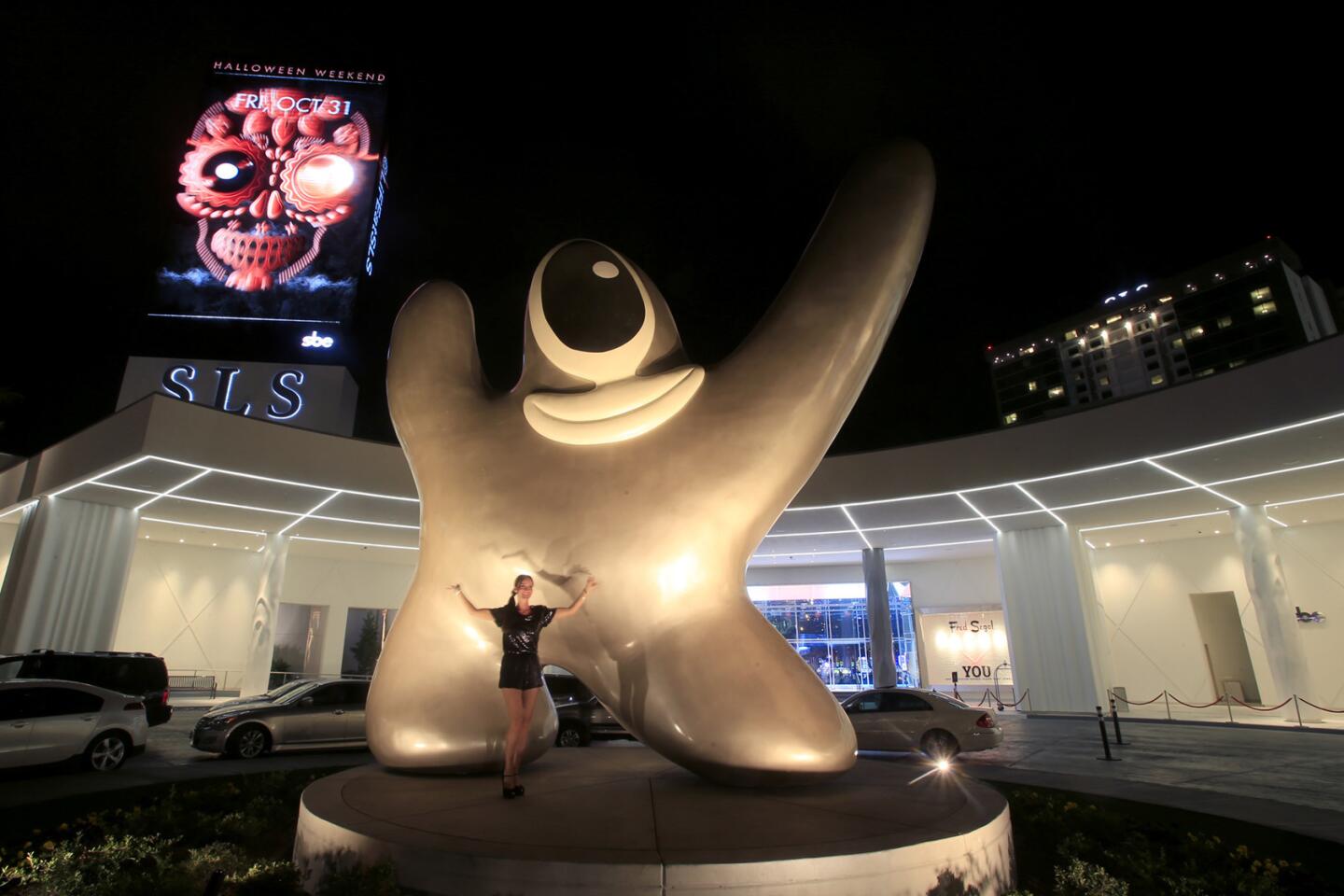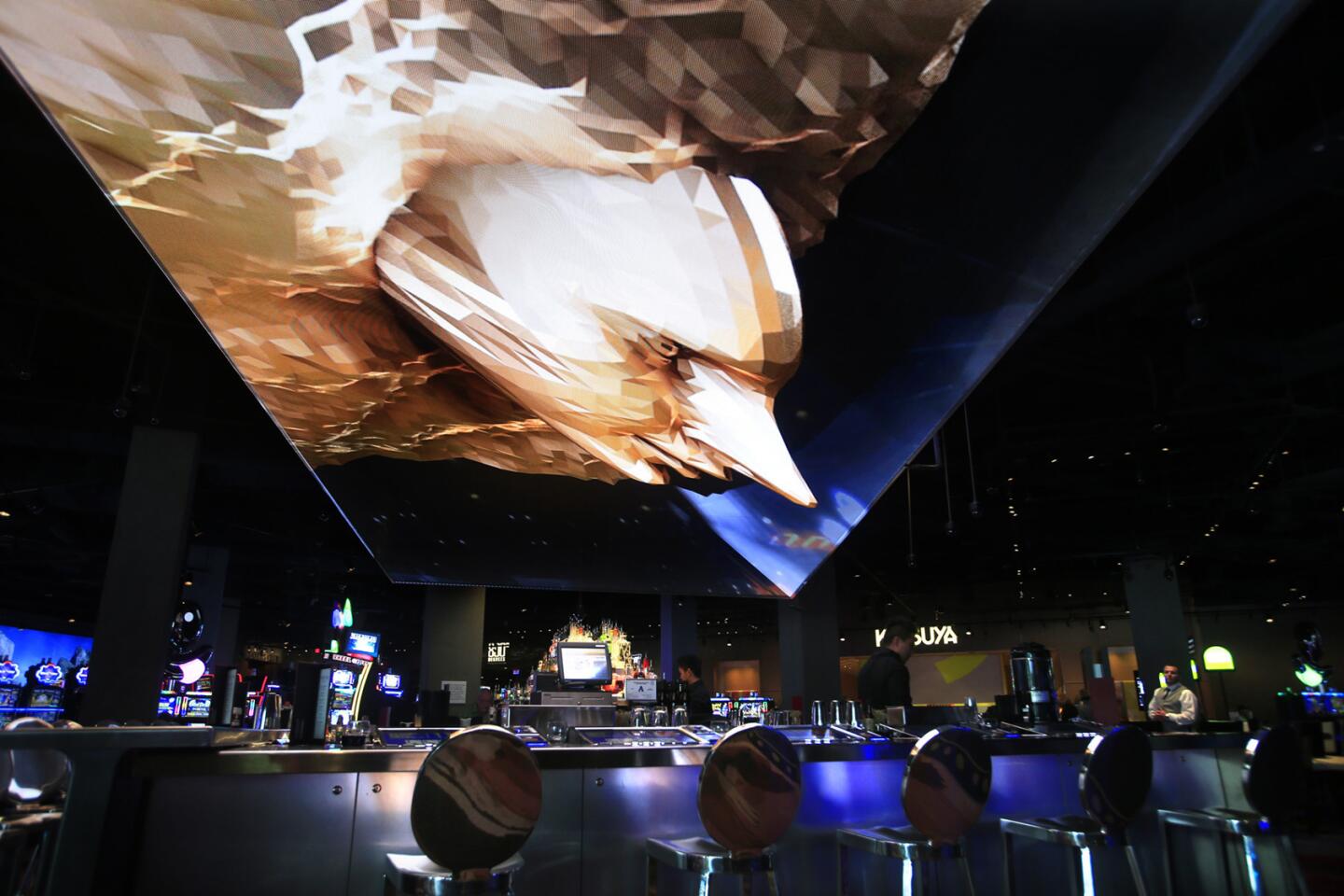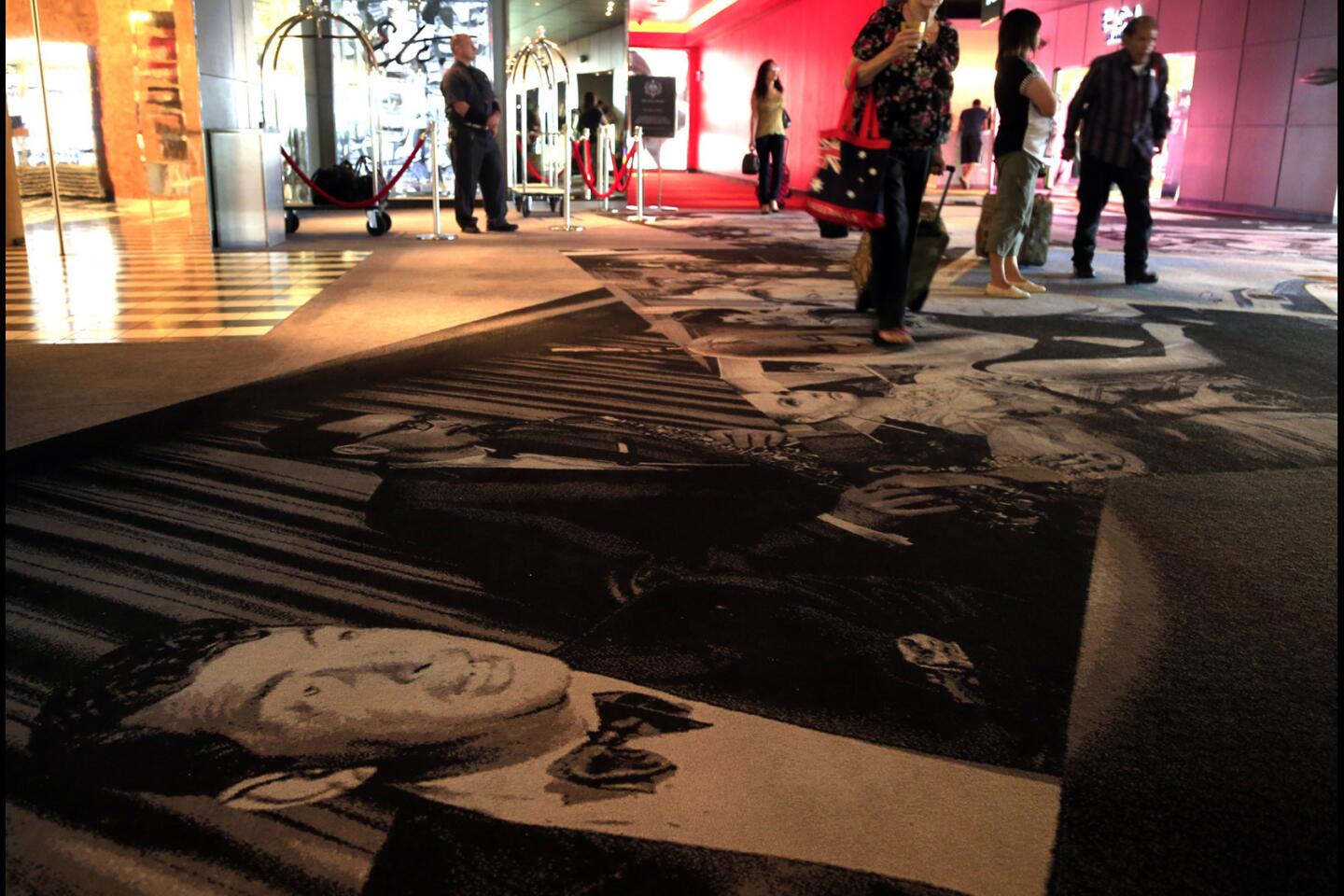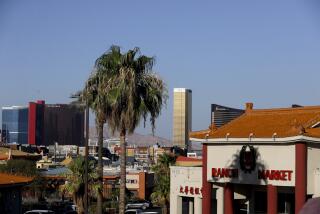L.A. nightclub operator Sam Nazarian bets on Las Vegas hotel-casino
- Share via
Los Angeles nightclub impresario Sam Nazarian opened his latest SLS hotel with the usual flair. Champagne flowed, rock tunes blared, celebrities preened and fireworks exploded from the trendy hotel’s roof on the Las Vegas Strip.
The light show cast an eerie glow on a neighboring property: the defunct, half-built Fontainebleau Resort. The liquidated hotel and casino, encircled by a weed-choked lot, is a reminder of how quickly fortunes change in Las Vegas.
Nazarian is making an $800-million bet on the decaying northern reaches of the Strip. The SLS Las Vegas, opened this summer, rose from the bones of the old Sahara Hotel and Casino, replacing Middle Eastern kitsch with modern flash.
“People were very skeptical that this project would even open,” said Nazarian, founder of SBE, the largest nightclub operator on the West Coast.
Las Vegas has a long history of killing fanciful casino dreams. But Nazarian is wagering that his Midas touch with swanky nightclubs and stylish hotels in L.A. will pay off in Sin City.
“The SLS is a milestone for so many reasons, not just for me personally but for the company,” he said.
If the project thrives, Nazarian can take credit for helping to spark a renaissance in a stretch of Las Vegas crowded with liquor stores, one-hour wedding chapels and seedy motels.
A success would also prove that Nazarian can hold his own against Las Vegas’ casino giants, including MGM Resorts International, Caesars Entertainment and Wynn Resorts.
But Nazarian is doing it his way. He’s counting on the SLS to flourish because of the hotel’s restaurants and nightclubs — not gambling.
The 1,600-room SLS in Las Vegas is by far the biggest of the six hotels that his company, SBE, has opened so far, and it sits in a neighborhood at a crossroads.
Across the street from Nazarian’s casino, MGM Resorts has purchased 34 acres to build an open-air concert venue, called Rock in Rio, to host 80,000 people. It is scheduled to open in May.
“That would make the SLS an attractive place to stay,” said Stephen Brown, director of the Center for Business & Economic Research at the University of Las Vegas.
Nazarian’s hotel is just two blocks from the Las Vegas Convention Center, which drew 1.2 million visitors last year. The Las Vegas Monorail also stops near the entrance to the SLS.
Las Vegas Councilman Bob Coffin, who represents the SLS neighborhood, said several nearby developments are in the pipeline but declined to disclose details.
Still, the project must overcome some serious obstacles.
Any development near the SLS must contend with the shadow of the Fontainebleau, a 68-story casino, hotel and condo project that was abandoned when the recession struck. The new owner, Icahn Enterprises, didn’t respond to requests for comment. The SLS hotel’s closest casino neighbor, the Stratosphere Casino, Hotel & Tower, has struggled with flat revenue and empty storefronts.
In addition, violent crime in the area north of the SLS climbed nearly 8% in the first 10 months of 2014 while crime citywide fell 2%, according to the Las Vegas Metropolitan Police Department.
In early October, less than two months after opening, the SLS Las Vegas laid off about 2% of its 3,000-member staff. Hotel officials described the move as an adjustment based on staffing needs.
For the SLS to overcome the area’s hurdles, Nazarian, 39, said he needs to draw visitors who fit his own demographic: young, 30-something club hoppers who earn at least $50,000 a year.
By tapping a database of 5 million past visitors to SBE clubs, lounges and hotels, Nazarian can send out email blasts and promotional deals to lure those guests.
“We want to create a special home for them,” said Arash Azarbarzin, SBE’s hotel division president.
In 2007, Nazarian paid about $400 million for the iconic Sahara, known as a hangout for Rat Packers Frank Sinatra, Dean Martin and Sammy Davis Jr. Financing came from San Francisco-based private equity firm Stockbridge Real Estate.
He was forced to close the hotel four years later, saying the recession made the project “not economically viable.” The axiom that gambling is recession-proof was proved wrong.
Visits to Las Vegas dropped 7% from 2007 to 2009, while gambling revenue sank 20% in the same period, according to the Las Vegas Convention and Visitors Bureau.
The recession also put the brakes on the Las Vegas cycle of imploding older casinos to make way for bigger, glitzier projects. At least five multibillion-dollar resort projects were mothballed during the financial slump, with a few, including the Fontainebleau, still on hold.
Once the economy gained momentum, Nazarian announced plans to rename, renovate and reopen the Sahara, with $300 million coming from J.P. Morgan Securities. An additional $400 million was raised from foreign investors.
The hotel opened in August with a bash attended by more than 3,000, including musicians Lenny Kravitz and Iggy Azalea and actors Jamie Foxx and Sharon Stone.
The party represented a pivotal night for Nazarian, an Iranian American entrepreneur who grew up in Beverly Hills but said he wasn’t cool enough to get into L.A.’s trendiest nightclubs.
In his early 20s, Nazarian made a small fortune by investing in a cellphone company and later plowed cash into the outdated Coconut Teaszer on the Sunset Strip, which he turned into a favorite haunt of celebrities. Other nightclubs followed, along with hotels, which he branded with the moniker SLS for style, luxury and service.
Nazarian has pulled back from the party scene to focus on business. He proposed to his supermodel girlfriend, Emina Cunmulaj, and lives in Las Vegas in an $8.5-million, 14,000-square-foot mansion in the hills that overlook the Strip — and the SLS.
Many Vegas hotel operators rent space to club or restaurant operators, but Nazarian owns and runs most of the nightspots and eateries in the SLS, including his own brand restaurants Katsuya and Bazaar Meat.
It’s a strategy adopted by his business idol, casino mogul Steve Wynn, and ensures that he keeps control of all the operations and their profits.
In another break from Las Vegas competitors, Nazarian heavily promotes the hotel’s clubs and restaurants — not the casino — because he says gambling is fading in Las Vegas.
“It’s not the main driver anymore,” he said.
The SLS casino is a third the size of the casino floor at the MGM Grand and half that at the Luxor Las Vegas. The SLS has baccarat, but no poker room.
Statistics suggest that Nazarian is on the right path. In the early 1990s, most of the revenue at Las Vegas resorts came from gambling. By last year, only 37% came from gambling, said David G. Schwartz, director of the Center for Gaming Research at UNLV.
Still, some SLS guests complain about making the long, hot march from the SLS hotel to bigger resorts on the Strip with more gambling options.
“I wish I didn’t have to walk so far,” lamented Neal Compton, an SLS guest from Utah who trekked to Caesars Palace in search of a poker room.
Ariel Xaubet, a Las Vegas marketing consultant, complimented the hotel’s service but complained that “the surrounding areas aren’t the nicest.”
But if Las Vegas continues to thrive and expand, Nazarian says, it must head north. The south end of Las Vegas Boulevard hits a roadblock at Interstate 215.
“In the short term, I understand the reality that we are not on Main Street,” he said. “But the energy has to come north. It can’t go south.”
Twitter: @hugomartim
More to Read
Inside the business of entertainment
The Wide Shot brings you news, analysis and insights on everything from streaming wars to production — and what it all means for the future.
You may occasionally receive promotional content from the Los Angeles Times.























